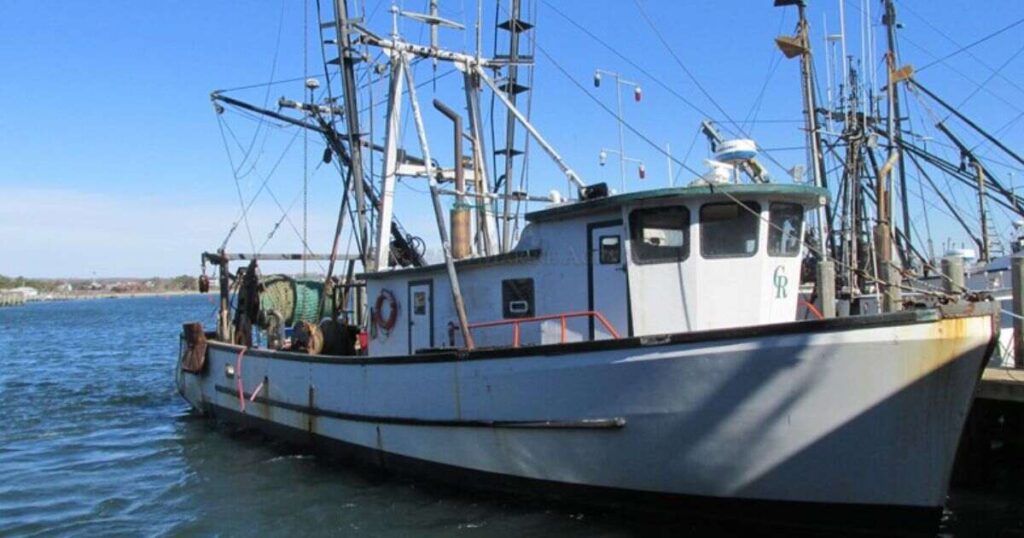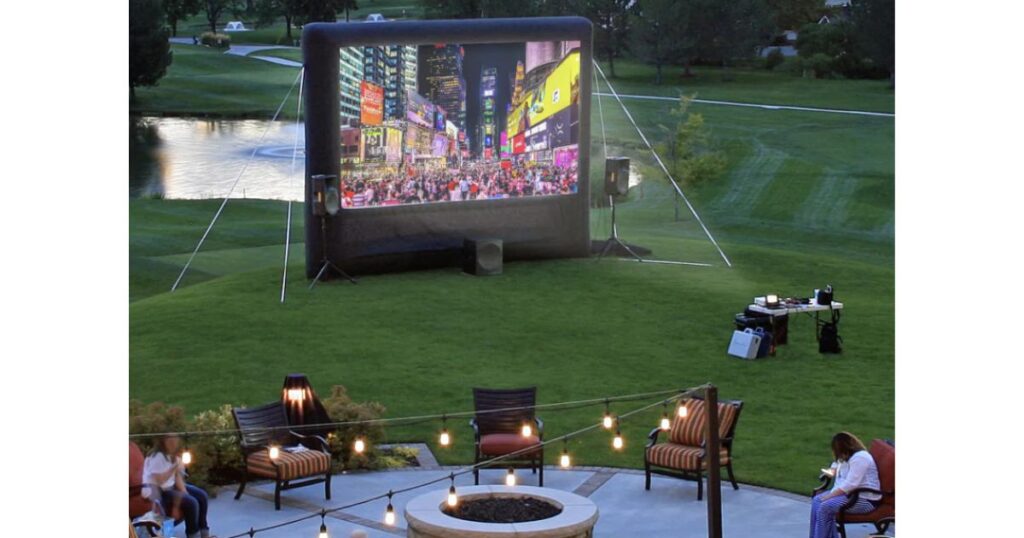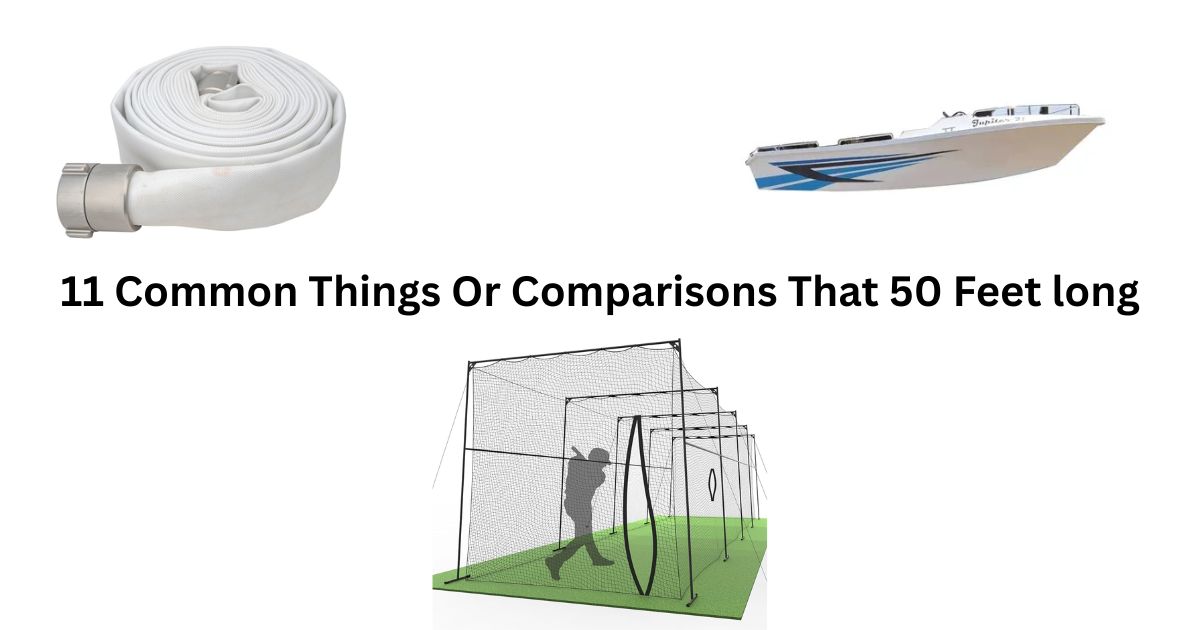Ever tried to picture fifty feet in your head and come up short? You’re not alone. Most people can imagine ten feet or maybe the size of a car, but fifty feet is harder to visualize until you’ve measured it yourself.
I learned that the first time I stretched a tape across my backyard to plan a fence. The numbers said “50 ft,” but seeing that line across the grass suddenly made the space feel huge. Since then, I’ve noticed that 50 feet quietly shapes so many everyday things — from city design to sports and even the tools we use.
Quick Perspective: What 50 Feet Really Means
- In metric: 50 ft = 15.24 meters = 600 inches = 16 ⅔ yards.
- In time: You walk it in about 11 seconds at a normal pace.
- In life: It’s half a basketball court or five compact cars in a row.
Fifty feet is long enough to need planning but short enough to fit into most real-world projects — a kind of “human-scale” distance that builders, sailors, and homeowners rely on.
11 Common Things Or Comparisons That Are 50 Feet Long
| Object | Category | Measurement/Dimension |
| Large Railroad Boxcar | Transportation/Freight | Interior cargo length: 50 ft (exterior: 55-60 ft) |
| Fire Truck (Aerial Ladder) | Emergency Vehicle | Overall length: 40-50 ft |
| Fire Hose (Standard Section) | Emergency Equipment | Single section length: 50 ft |
| Coast Guard Patrol Boat | Maritime Vessel | Defender-class length: ~50 ft |
| Small Commercial Fishing Trawler | Maritime Vessel | Bow-to-stern length: ~50 ft |
| Helicopter Rotor | Aircraft Component | Sikorsky S-61 rotor diameter: ~50 ft |
| Outdoor Movie Screen | Entertainment | Screen width: 50+ ft |
| Residential Street | Infrastructure | Curb-to-curb width: ~50 ft (two-lane) |
| Shallow Well | Utility/Water Source | Drilling depth: ~50 ft |
| Indoor Batting Cage | Sports Equipment | Net system length: 50 ft |
| Small Retail Store | Commercial Building | Front-to-back depth: 50 ft (strip mall unit) |
1. Large Railroad Boxcar

If you’ve ever watched a freight train rumble by, you’ve probably seen those massive boxcars that seem to stretch forever. A standard large boxcar measures about 50 feet inside, as noted by the Trains making it one of the most recognizable examples of this length. Standing beside one on a rail platform gives you an instant sense of how long 50 feet really is.
These cars were designed for maximum cargo without tipping the balance on the tracks. They carry everything from vehicles to grain, and their size became a freight industry standard decades ago. When you see a single boxcar pass, that’s roughly one perfect “unit” of 50 feet right there on steel wheels.
2. Fire Truck

Those huge fire trucks with long ladders mounted on top? The biggest ones — called aerial ladder trucks — often measure around 50 feet long from front to back. These aren’t your neighborhood pumpers; they’re the heavy-duty giants you see in city firefighting units.
That length makes room for an extended cab, a water tank, multiple storage compartments, and the massive hydraulic ladder that can reach high floors. Seeing one parked on the street can help you instantly imagine how long 50 feet really looks stretched across pavement.
3. Fire Hose (Standard Section)

Every section of a firefighter’s hose is exactly 50 feet long — and that’s not by accident. It’s long enough to reach building entrances or move around corners but still light enough for firefighters to handle quickly during emergencies.
If you’ve ever seen them connecting multiple hoses together during a blaze, you can imagine how easily these 50-foot sections build up hundreds of feet in seconds. Each section is a manageable piece of lifesaving equipment designed with both distance and speed in mind.
4. Coast Guard Patrol Boat (Small)

Every section of a firefighter’s hose is exactly 50 feet long according to U.S. Coast Guard vessel specifications— and that’s not by accident. It’s long enough to reach building entrances or move around corners but still light enough for firefighters to handle quickly during emergencies.
If you’ve ever seen them connecting multiple hoses together during a blaze, you can imagine how easily these 50-foot sections build up hundreds of feet in seconds . Each section is a manageable piece of lifesaving equipment designed with both distance and speed in mind.
Related: How Long Is 100 Feet? 13 Common Comparisons That Are 100 Feet Long
5. Small Commercial Fishing Trawler

Walk along a fishing pier, and you’ll notice that many independent trawlers fall right around 50 feet long. That length gives the crew enough deck space to store nets, haul in catches, and still live aboard comfortably for short trips.
For small fishing businesses, 50 feet is the sweet spot between power and practicality. Boats this size can weather tough conditions but don’t require massive crews or fuel costs. It’s the everyday workhorse of coastal communities — and another perfect real-world picture of 50 feet.
6. Helicopter Rotor Diameter

Stand near a large helicopter, and you’ll notice the main rotor blades form an enormous spinning circle. On aircraft like the Sikorsky S-61, that circle measures about 50 feet across — from one blade tip to the opposite one.
Imagine a rotating disc wide enough to cover the length of a suburban street lane. That’s how much air those blades move to lift the entire helicopter. It’s an incredible engineering feat and a great reminder that 50 feet isn’t just about length — it can define power, lift, and motion.
7. Outdoor Movie Screen

Drive-in theaters and outdoor event venues often use screens around 50 feet wide to give the audience a perfect view. That width is enough for hundreds of people or cars to see clearly without anyone feeling too far from the action.
Standing in front of a 50-foot-wide screen feels impressive — almost like a building wall turned into a giant glowing surface. If you’ve been to a drive-in movie, you’ve already seen what 50 feet looks like stretched across the night sky.
8. Residential Street Width (Curb-to-Curb)
A two-lane neighborhood street is usually about 50 feet wide from curb to curb. It’s a dimension most of us cross daily without thinking. That width allows two cars to pass comfortably with room on both sides for parked vehicles.
Next time you walk across your street, count your steps — it will take around twenty normal paces to cover it. That’s what 50 feet feels like in everyday movement, a simple and subtle distance built into modern design.
9. Depth of a Shallow Well
In areas where the water table sits close to the surface, a home well might reach about 50 feet deep as reported by the U.S. Environmental Protection Agency. That’s enough to tap into a clean, steady supply of groundwater without drilling hundreds of feet down.
It’s strange to think about — the same 50 feet that describes a boxcar’s length can also measure how far underground fresh water flows. Beneath lawns, farms, and small towns, thousands of wells stretch down exactly that far to bring water to the surface.
10. Indoor Batting Cage

Walk into a baseball training center, and you’ll likely see batting cages around 50 feet long. That length gives players enough distance to see the ball, swing fully, and keep everything safely contained within the netting.
Coaches use 50 feet as a perfect training distance — realistic enough to simulate gameplay but short enough to fit indoors. If you’ve ever practiced hitting in one, you’ve stood inside an exact 50-foot space without even realizing it.
11. Length of a Small Retail Store
Many small retail spaces, especially those in strip malls, measure about 50 feet deep from the front door to the back wall. That depth gives store owners enough room for displays, storage, and office space without wasting any square footage.
The next time you walk into a local shop, notice how far it feels from the entrance to the checkout at the back — that visual depth is roughly 50 feet. It’s one of the most practical and profitable lengths in commercial design.
Read Also: 13 Common Things That Are 4 Inches Long
Visualizing 50 Feet in Real Life
If you don’t have a tape measure, you can still estimate 50 feet easily. Twenty normal walking steps equal about that distance. Or picture three midsize cars parked end to end, or half a basketball court. Once you practice seeing 50 feet, it becomes second nature in daily life.
The next time you plan a project or try to picture a distance, think of one of these examples — a street, a screen, a fire hose, or even a small boat. They’re all around 50 feet long, and now you can visualize it clearly anytime you need to.
FAQs About 50 Feet
How many meters is 50 feet?
It equals 15.24 meters. To picture that, think of the length of a city bus or three compact cars parked bumper to bumper.
What are some common things that measure about 50 feet?
Fire truck ladders, small Coast Guard boats, fishing trawlers, boxcars, drive-in movie screens, helicopter rotors, and indoor batting cages all reach around this length.
How long does it take to walk 50 feet?
At an average pace of 3 miles per hour, you’ll cover it in about 11 seconds. A brisk walk takes closer to 7 or 8 seconds, and a light jog about 5.
Can I measure this distance with my phone?
Yes. Apps like Measure (iPhone) or Google Measure (Android) use your camera to estimate length through augmented reality. They’re not perfect, but great for quick checks.
Which is longer—50 feet or 50 yards?
Fifty yards wins easily. Since one yard equals three feet, 50 yards = 150 feet, three times the length.
How deep would a 50-foot pool be?
That would be unusually deep. Most backyard pools reach only 8–10 feet. A 50-foot depth is closer to the scale of wells or underwater research tanks.
Is that a good length for a driveway?
For many suburban homes, yes. It usually fits two parked cars comfortably and provides enough room from street to garage, though larger lots may need more.
Wrapping Up
Once you start noticing this distance in real life, you’ll spot it everywhere—from the span of a street to the length of a train car. Understanding what 50 feet looks like helps with everyday estimating, from home projects to travel planning.
It’s a measurement that connects small spaces and big environments, giving you a practical sense of scale in the world around you. Next time you’re outside, walk about twenty steps—you’ve just covered fifty feet. Simple, useful, and surprisingly common.

I am the editor and author of StoriesRadius.com, a blog about measurements and dimensions. I enjoy turning numbers and sizes into simple stories that anyone can understand. From everyday objects to curious facts, I share clear guides based on real research and experience. My goal is to make learning about length, height, and size fun, useful, and easy for all readers.










